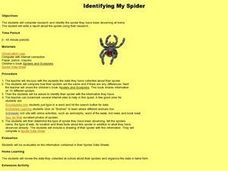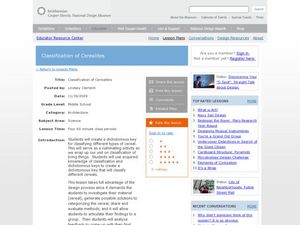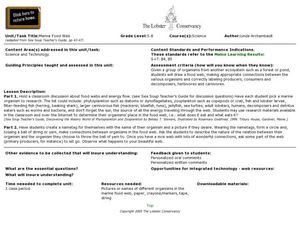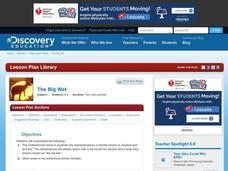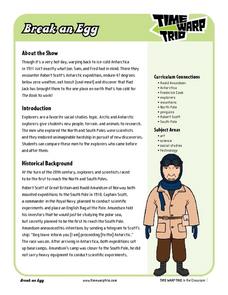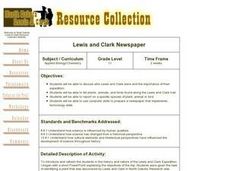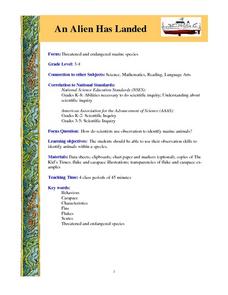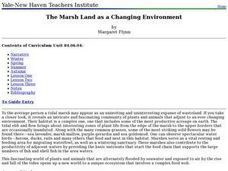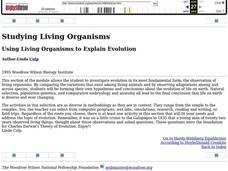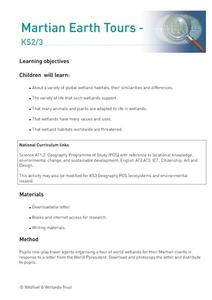Curated OER
Identifying My Spider
Third graders navigate the Internet and research spiders. In this spider lesson, 3rd graders view photos of spiders and use their characteristics to determine the variety of spider. Students complete a spider data sheet.
Curated OER
Comparing Sea Horses and Knights
Students investigate sea horses and knights. In this marine biology lesson, students read the book How to Hide an Octopus and discuss the purpose of camoflage. Students research knights and sea horses and record their research on...
Curated OER
Classification of Cerealites
Students create a dichotomous key. In this categorizing activity, students create a dichotomous key for different types of cereal. Students classify the cereal into groups such as flakes and cereal with holes. Students discuss their...
Curated OER
Marine Food Web
Students investigate the effects of the food chain on all animals by creating a food web. For this seafood lesson, students discuss energy flow and research a specific marine organism of their choice. Students create a food...
Curated OER
Blue Planet: Seasonal Seas
Students study and research marine invertebrates. In this marine lesson students create an illustrated report and help complete a class exhibit.
Curated OER
The Big Wet
Students complete a research project. In this climate lesson, students learn about the climate "tropical wet and dry" found in Australia. Students work in groups to research aspects of this climate and then create a class presentation.
Curated OER
Problem Based Learning Scenario
Students research about the function of MPA's. In this marine science lesson, students explore how humans influence changes near these areas. They explore different MPA's in the Great Lakes region.
Curated OER
Break an Egg
Young scholars research antarctic wildlife and create a diorama and fact sheet to present their research to the class. They create an Antarctic explorer's journal.
Curated OER
Design a Deep- Sea Vertebrate or Invertebrate
Learners design a deep-sea animal. In this research based lesson, students research and design a vertebrate or invertebrate that lives in a methane hydrate habitat. They compile a class chart of the adaptations animals have in this...
Curated OER
Tooth Be Told
Students consider the images and feelings associated with teeth. They also create posters about the importance of teeth in a variety of animals.(August 5, 2003)
Peace Corps
Weather and Water in Ghana
Students investigate the climate of their region. Students research statistics and conduct interviews. Students take a virtual tour of Ghana and discuss its climate. Students consider water conservation and the role it plays in both...
Curated OER
Ecotourism in National Parks and Wilderness
Young scholars develop a plan for ecotourism after researching a nearby national park or wild area.
Curated OER
Lewis and Clark Newspaper
Eleventh graders discuss who Lewis and Clark were and the importance of their expedition, list plants, animals, and birds found along the Lewis and Clark Trail, report on a specific species, and prepare a newspaper that implements...
Curated OER
An Alien Has Landed
Learners identify animals within a species by using their observation skills to record information, such as behavioral characteristics.
Curated OER
A Field of Beans
Beans, or legumes as they are sometimes called, are the topic for an integrated multi-subject lesson. Youngsters will read, write, observe, and research everything there is to know about beans. They read a bean story, conduct a bean...
Curated OER
Changing With the Tide
Students research and they role-play the behavior of plants and animals in a salt marsh habitat as the tides change.
Michigan Sea Grant
Invasive Species
Learners identify invasive species to the Great Lakes and analyze their impact on the ecosystem. Using photo cards with pictures and facts, young scientists work in small groups to match invasive species with their corresponding...
Curated OER
The Marsh Land as a Changing Environment
Sixth graders continue their examination of the state of Connecticut. After taking a field trip, they identify the types of birds, plants, invertebrates and vertebrates who make their home in the salt marshes. In groups, they identify...
Curated OER
Who Gives a Hoot?
Students look at owl migration and its impact on the environment and the food chain after reading an article from The New York Times. Students then apply this information to and research different food chain situations for other species...
Curated OER
Using Living Organisms to Explain Evolution
Students investigate evolution in its most fundamental form: the observation of living organisms. By comparing variations that exist among living animals, students formulate their own hypotheses and conclusions about the evolution of...
Curated OER
Molecular Approaches to Evolution
Students examine the molecular studies of organisms that have led to a new era in their understanding of speciation and evolutionary relationships. Students study the allelic frequency of genes controlling specific molecules and assess...
Curated OER
Martian Earth Tours
Students study a variety of global wetland habitats, their similarities and differences. They examine the variety of life that such wetlands support and determine that many animals and plants are adapted to life in wetlands, that...
Curated OER
Under the Sea
Young scholars identify and interpret that non-fiction books have features like a table of contents, a glossary, and an index, which can efficiently help them find information. They also identify how to narrow the search for information...
Curated OER
The Clone Age
Young scholars relate the ethical and practical arguments in favor of cloning and against cloning. They research the issue and plan a public service advertisement campaign for or against cloning.
